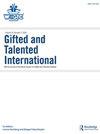Editorial
Q3 Social Sciences
引用次数: 0
Abstract
This is the third issue of Gifted and Talented International, the journal for the World Council for Gifted and Talented Children, that has been published online with Taylor and Francis. In this issue of Gifted and Talented International we have four articles with research findings from four different international contexts with important implications for supporting and teaching gifted and creative students for talent development. In the first article, the authors Ghahremani, Karami, and Balcaen focus on gifted science classrooms in Iran’s special schools for gifted students. The researchers investigated teachers’ instructional strategies for developing the students’ critical thinking, in addition to expert teachers’ culturally informed habits of mind that were identified. Interviews with the expert teachers resulted in the development of a culturally informed five elemental pentagram of habits of mind. In the second article, the authors Kerr, Birdnow, Hallaert, Alexander, Malmsten, Stull, Wright, Lucas, Swanson, and Claiborn studied innovation in Iceland in a range of fields including design, music, art, and literature. The researchers used a literature review, observations, interviews, and artifacts to examine why Iceland is so innovative. The researchers found that the creativity literature supported the idea that ability and personality attributes of Icelanders might be the source of Icelandic innovation. The popular literature often has referred to an environment of extremes and natural beauty that inspires higher rates of creativity and innovation, while the scholarly literature specifically relating to Iceland has suggested that open and egalitarian families; innovation education curricula and free play; cultural support for creativity; and government policies have propelled innovation in Iceland. However, the researchers’ observations found that interviewees often disputed the literature, particularly regarding the impact of high ability, natural environment, and policy on innovation, and that artifacts supported most environmental variables. In the third article in this issue of Gifted and Talented International, Miller and Smith explore differences in several aspects of creativity across academic majors for high-ability Honors College students in a Midwestern university in the United States. The authors found that the pattern of results generally indicated higher creativity among arts and humanities majors, compared to other disciplines such as education and preprofessional training, although these fields could also benefit from creative input. Potential curricular and experiential reasons for these differences were discussed, in addition to implications for educational programming and interventions. The fourth research study in this journal was conducted with Year 10 academically able students in the first co-educational select-entry secondary college in Victoria, Australia. The researchers of this study, Kronborg, Plunkett, Gamble, and Kaman, investigated a range of motivational constructs, including locus of control and resilience, and found that among these academically able students, those with a more internally focused locus of control were more resilient. We trust that these research articles and their international setup add to our current knowledge and understanding in gifted education.社论
这是《国际天才与天才》杂志的第三期,该杂志是世界天才与天才儿童理事会的杂志,与泰勒和弗朗西斯一起在网上出版。本期《资优国际》刊载了四篇来自四个不同国际背景的研究成果,对支持和教育资优和有创造力的学生以促进才能发展具有重要意义。在第一篇文章中,作者Ghahremani、Karami和Balcaen将重点放在了伊朗为天才学生开设的特殊学校的天才科学教室上。研究人员调查了教师培养学生批判性思维的教学策略,以及专家教师的文化知识思维习惯。与专家教师的访谈导致了一种文化知情的思维习惯的五元素五角星的发展。在第二篇文章中,作者Kerr、Birdnow、Hallaert、Alexander、Malmsten、Stull、Wright、Lucas、Swanson和Claiborn研究了冰岛在设计、音乐、艺术和文学等一系列领域的创新。研究人员使用文献综述、观察、访谈和人工制品来研究冰岛如此创新的原因。研究人员发现,创造力文献支持冰岛人的能力和个性属性可能是冰岛创新的来源这一观点。通俗文学经常提到一个极端的环境和自然美景激发了更高的创造力和创新率,而专门与冰岛有关的学术文献则表明,开放和平等的家庭;创新教育课程与自由游戏;对创意的文化支持;政府政策推动了冰岛的创新。然而,研究人员的观察发现,受访者经常对文献提出异议,特别是关于高能力、自然环境和政策对创新的影响,以及人工制品支持大多数环境变量。在本期《天才国际》的第三篇文章中,米勒和史密斯探讨了美国中西部一所大学的高能力荣誉学院学生在不同专业的创造力方面的差异。作者发现,结果的模式通常表明,与教育和职业前培训等其他学科相比,艺术和人文专业的学生具有更高的创造力,尽管这些领域也可以从创造性投入中受益。除了对教育规划和干预的影响外,还讨论了这些差异的潜在课程和经验原因。本杂志的第四项研究是对澳大利亚维多利亚州第一所男女同校的择优录取中学的10年级学生进行的。本研究的研究者Kronborg, Plunkett, Gamble和Kaman调查了一系列动机结构,包括控制点和弹性,并发现在这些学习能力强的学生中,那些更关注内部控制点的学生更有弹性。我们相信,这些研究文章和他们的国际设置增加了我们目前对资优教育的认识和理解。
本文章由计算机程序翻译,如有差异,请以英文原文为准。
求助全文
约1分钟内获得全文
求助全文

 求助内容:
求助内容: 应助结果提醒方式:
应助结果提醒方式:


